Toy for adult children - Parrot Bebop Drone Review
1: Hi, I have a wife on the 18th week
2: And on my 12th, and who are you waiting for a boy or a girl more?
1: Boy
2: Why?
1: Helicopter I want a radio-controlled
Bashorg.
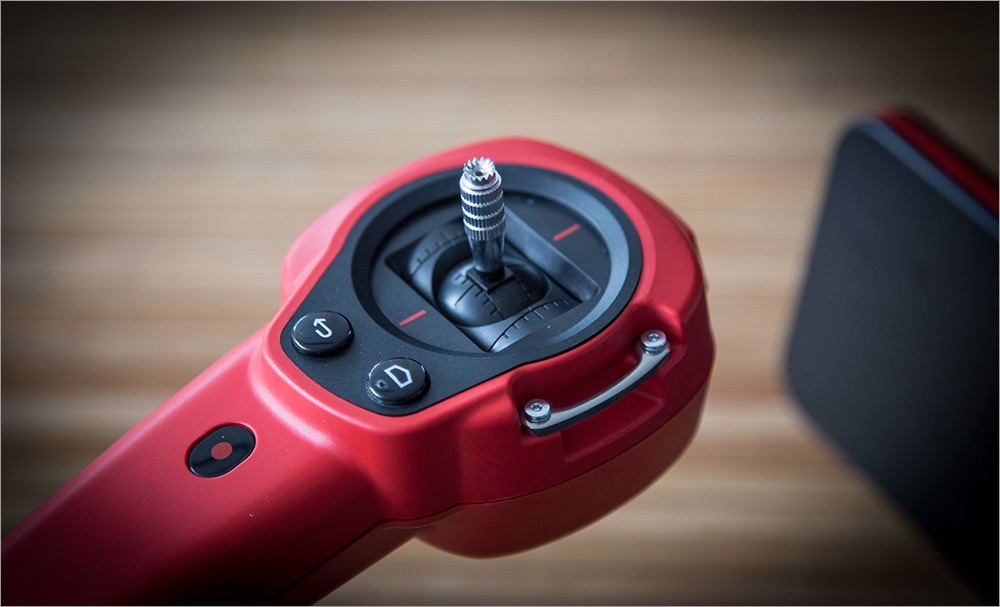
Sorry, it's just hard to start a quadcopter review from something else. So. The French company Parrot became known in 2010 and entered the small company of manufacturers involved in the rise in popularity of quadcopters in the consumer market. Since then, Parrot has managed to receive an award at CES 2010 in the Electronic Gaming Hardware nomination, and then release two more modifications of the aircraft. The latest model Parrot Bebop Drone (aka AR.Drone 3 ) came to us for a review and we are ready to share our impressions.
The initial success of Parrot is largely due to the original concept of synthesizing several technical ideas at once, which were developed throughout all three versions of the device. The quadcopter is piloted using a smartphone or tablet on iOS or Android, and synchronization is performed via a Wi-Fi network “originating” from the drone itself. Such "mobility" for the past generation of quadcopters allowed to create amateur applications with which the flight turns into an adventure with additional reality. Finally, Linux OS is used as a software filling, which allows you to fix various bugs by updating the firmware.
')
We received an overview of the advanced package of Parrot Bebop Drone, which includes:
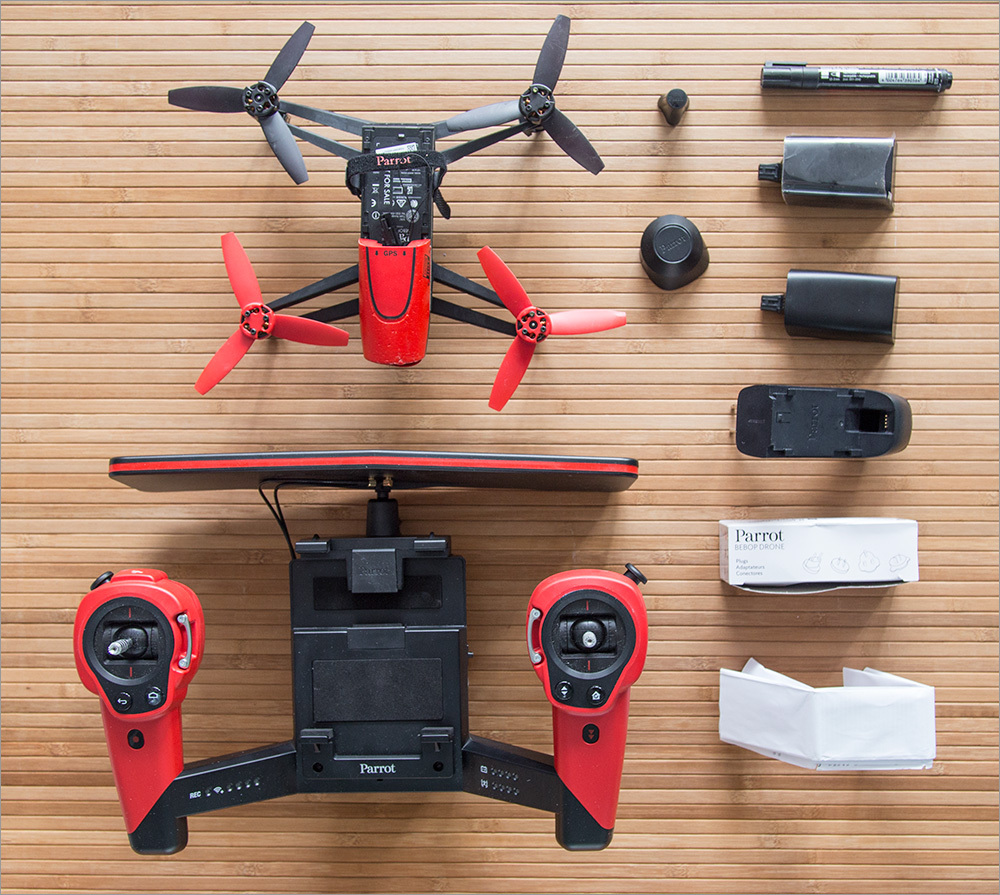
Unlike AR.Drone 2, the new Parrot Bebop has become much more compact and now looks more like a drone spy with an aggressive design, rather than a massive helicopter with an overall hull. We got the device in red and, I must say, this option looks the most predatory. Yellow and blue color options are also provided. Such a bright color scheme will allow not to lose the copter from the view in the open area.
The main material of the frame is ABS plastic, reinforced with fiberglass. Propellers made of polycarbonate, spaced apart. "In the bare" state, they are not protected from collision while flying and, accordingly, can easily hurt. With AR.Drone 2, a large protective frame was envisaged, framing the drone around the perimeter. Here, in order to reduce the sail, it is proposed to use two more compact foam bumpers.
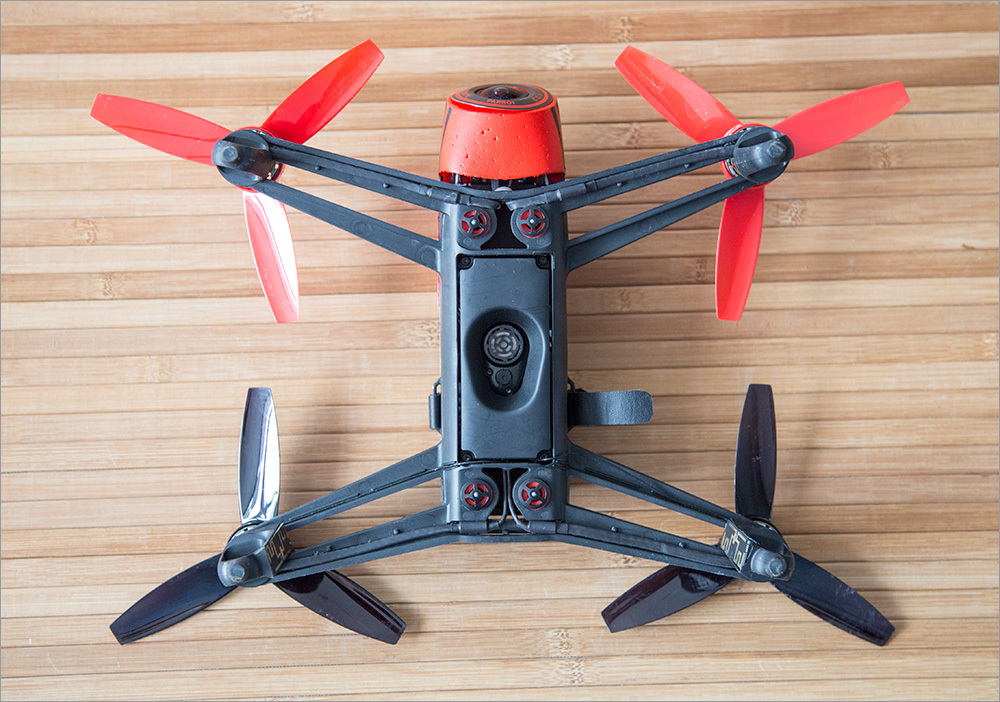
The back of the case is designed to install the battery. It is fixed in small slots, and then fixed with the body of the drone with a velcro fastener. This mount does not look very reliable, but accidental loss of the battery pack is excluded. From here you can also see the shock-absorbing rubber pads, located between the body of the copter and the frame. They are designed to deal with vibration, which in turn adversely affects, for example, video filming.
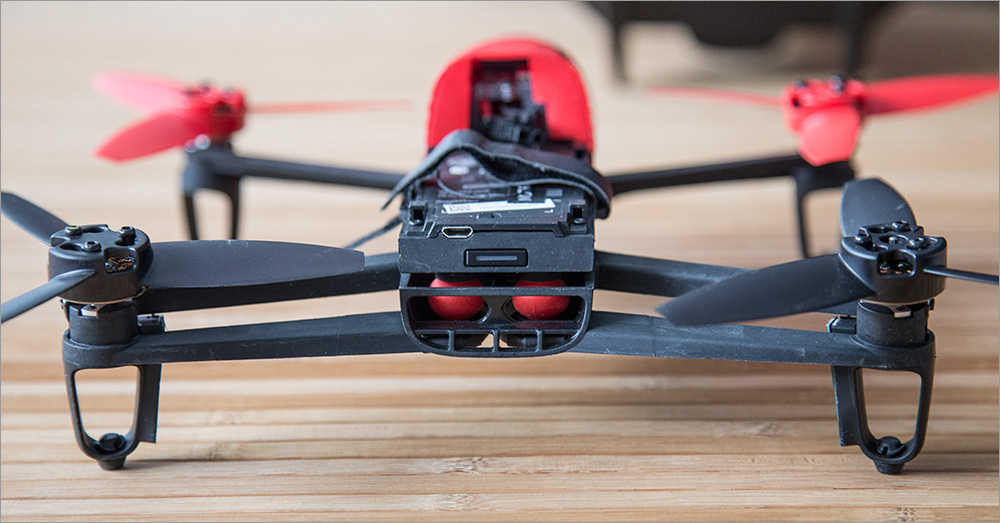
The front is decorated with impressive dimensions of the "eye" of the camera, which has been significantly improved since the second version of the drone. A 14-megapixel camera with a wide-angle lens “Fisheye” allows you to shoot video in FullHD format, as well as a photo in the form of a round panorama at maximum resolution.
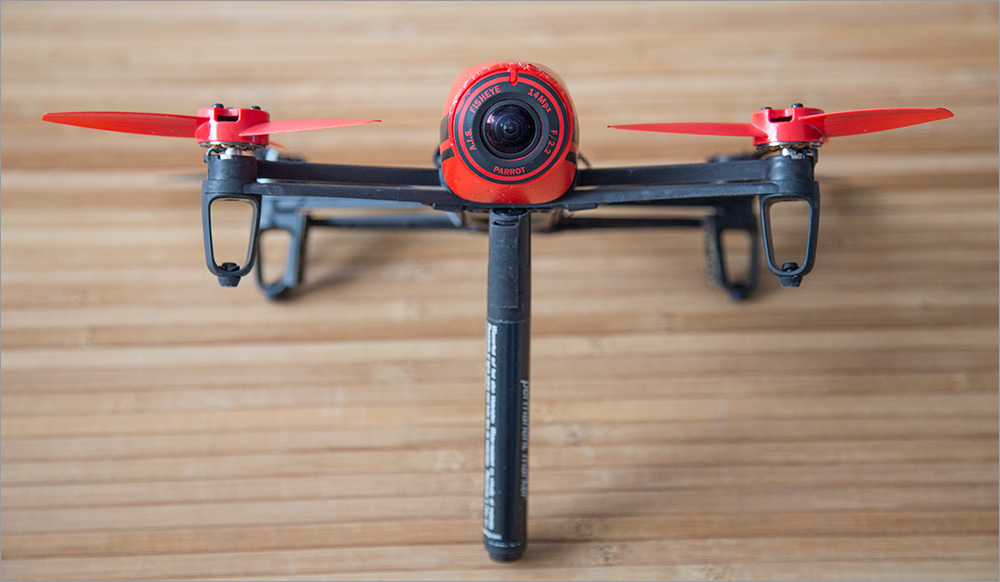
Skycontroller control panel is supplied only in an extended set. It allows you to conveniently fix the tablet and control using separate hardware keys and two joysticks.
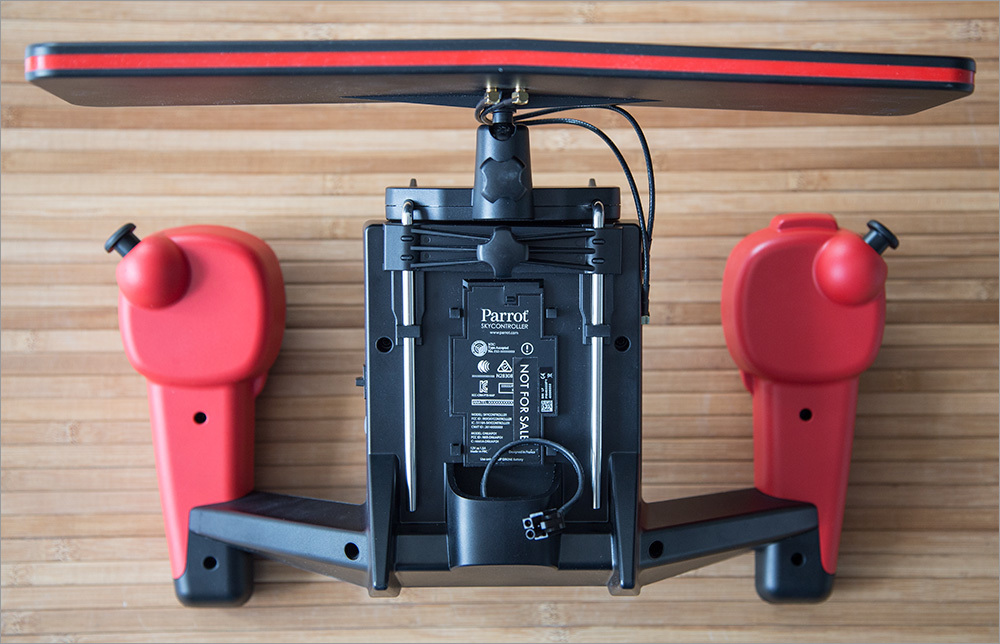
The console itself is running Android and is equipped with a whole arsenal of iron, which also allows you to increase the distance of remote piloting to 2 kilometers. The latter is achieved through a dual-band antenna. In the basic version, piloting is carried out through the proprietary application Freeflight 3.0, available for devices on Android , iOS and Windows Phone (beta) .
To liven up the quadcopter, you need to connect the battery and press a small key on the back of the case. After that, the LED starts flashing green, indicating that the system has started booting up and the network is “booming”. In the case of using a smartphone or tablet for piloting, the maximum range reaches 250 meters due to four antennas with a frequency of 2.4 and 5 GHz and Wi-Fi 802.11ac MIMO. As for the height, the manufacturer recommends a distance of 12 meters. It is quite possible to rise higher, but only in conditions of calm weather - the weight of the copter is only 380 grams without protective bumpers.
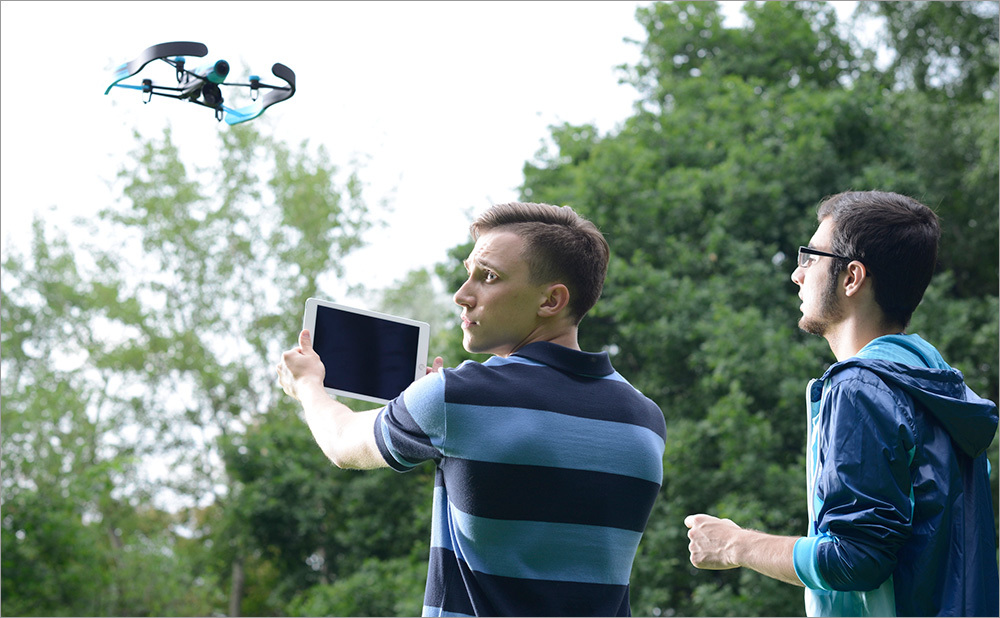
However, if the weather conditions do not threaten the drone with wind drift, then you can safely turn off the eye and fly freely. If the device is removed within the range of the network and loses the connection, it will automatically return to the launch point via GPS, having previously typed 10 meters in height.
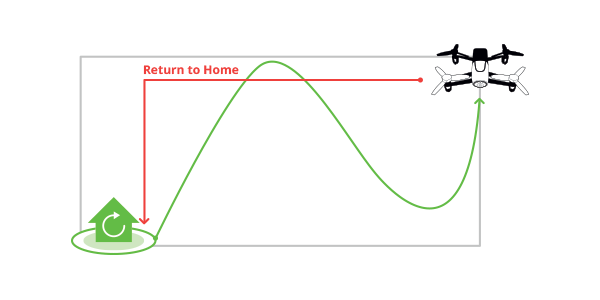
From a fully charged battery with a capacity of 1200 mAh, the drone can fly for about 10-15 minutes with a maximum speed of 45 km / h. When recording video, the running time is reduced by a couple of minutes.

In previous versions of the company's drones, the figures were similar, taking into account less powerful cameras and engines. As mentioned above, the kit comes with three universal batteries at once - two are designed directly for the copter, and one for the Skycontroller. To replenish the charge of the battery, it takes about 90 minutes of charging.
As in the previous version of the application, Freeflight 3.0 was created not only to control the quadcopter. For example, through it you can calibrate the device and update the firmware. By the way, just a few days ago Parrot updated the application for iOS, which includes the following changes:
All functions are available from the main menu after synchronizing the device with the drone. The settings indicate the initial position of the drone in height, to which it rises after the start of piloting. By the way, the distance is determined by the ultrasound module located on the bottom of the case.
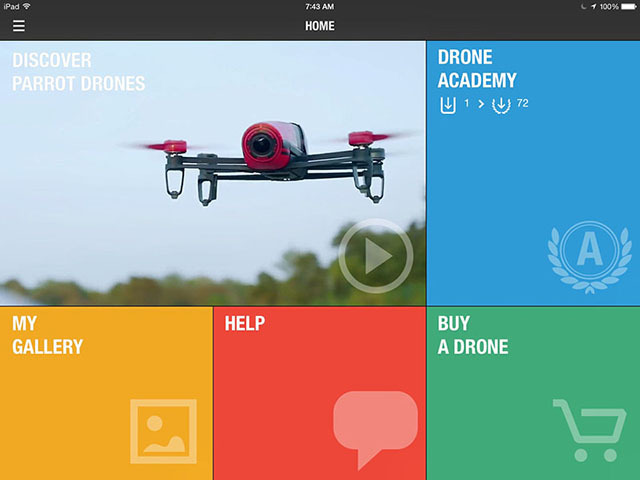
The range finder can force the drone to do unexpected maneuvers while controlling the room. For example, if the room is filled with furniture, the range finder will calculate the distance directly from the near obstacle, and not from the floor. It is not excluded that after finding the next imaginary landmark, the drone will be able to rest against the ceiling. The design of the copter is made in such a way that the collision will occur directly to the body. This means that damage to the propellers in this scenario is excluded.
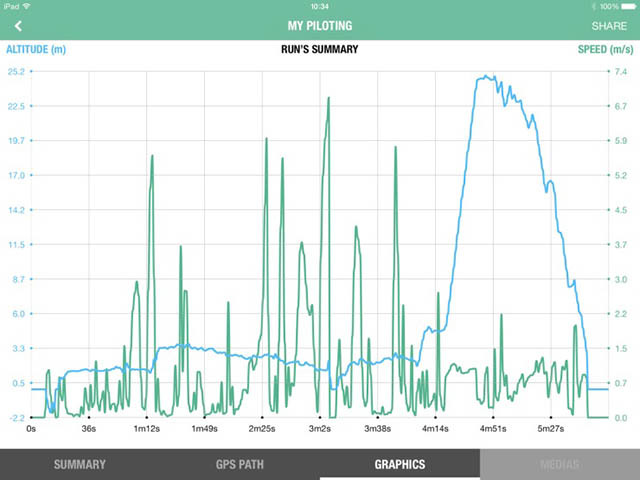
In piloting mode, the video from the camera on which the navigation marks are marked is transmitted to the screen. So, in the middle a small icon is shown with the quadcopter position for monitoring in case the drone is out of sight. Information about the speed of the copter, height, signal level and battery charge are displayed at the bottom of the screen.
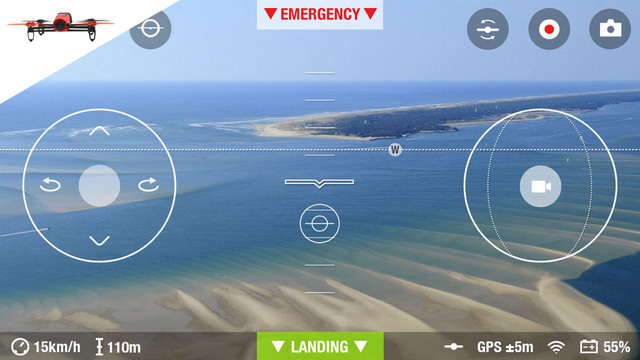
Management is carried out by virtual joysticks. The thumb of the left hand will adjust the height of the flight and other movements, and the inclinations are made through the accelerometer by tilting the device in the appropriate direction. The left joystick is designed to control the angle of the camera. The individual keys on the right side of the display are responsible for flips, shooting video and panoramic photos.
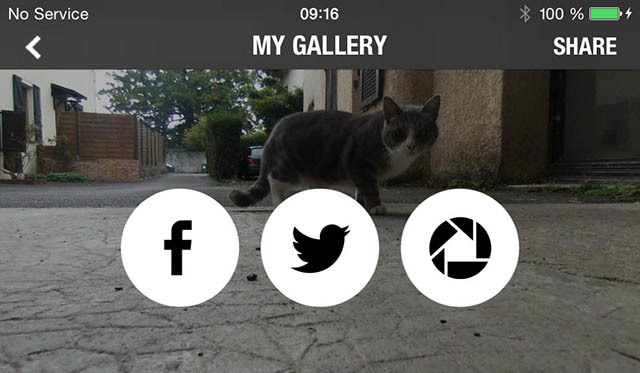
Another interesting feature is the “flight plan.” By analogy with more serious drones, Parrot Bebop is able to perceive geolocation commands through the application. It is enough to map a few marks, after which the copter will automatically overcome the intended trajectory. Flight programming becomes available through the GNSS chip and tracking system via GLONASS and GPS.

In general, the control system using the application remains the same. The behavior of the copter has changed significantly - Parrot Bebop responds more smoothly and predictably to all commands. This is especially felt when monitoring with the help of Skycontroller. The device provides several options for control.
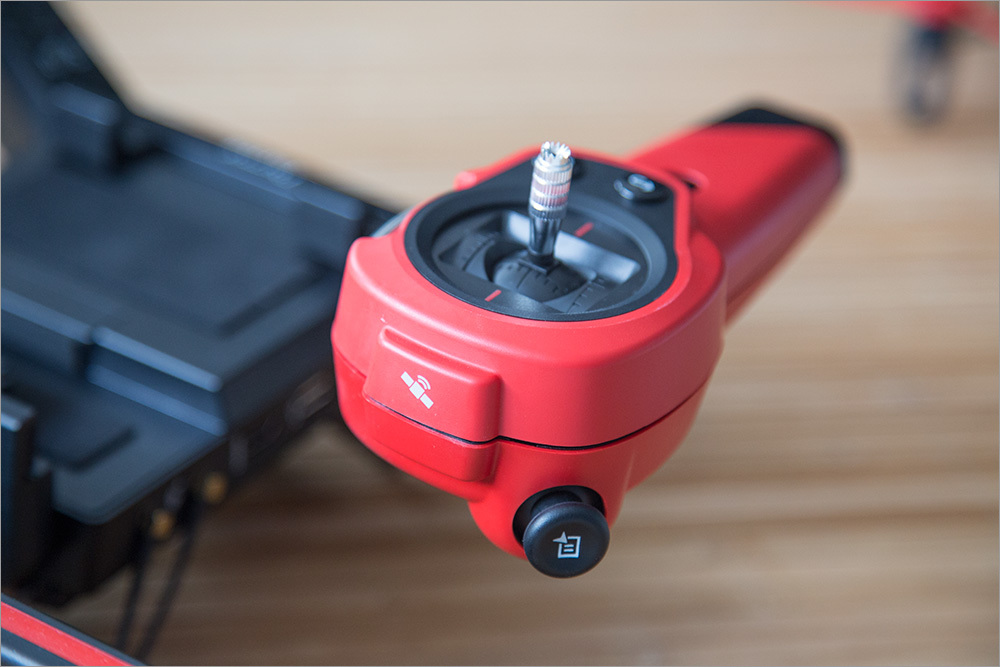

If a maximum range is required, only Skycontroller should be used. On the case are indicators of the charge of the console and the drone, as well as the signal level, which, in fact, allows you to do without a tablet or smartphone.

If you use a controller paired with a tablet, which is inserted into a special holder (thanks to which a tablet with any popular diagonal will fit), then the range will be limited to the near network, and the control will be carried out using the remote controls. In this case, the physical keys for navigating the mobile application also become available, and this, it is necessary to recognize, is the most convenient option for controlling the drone.
Finally, in the case of the console there is an HDMI connector, through which it will be possible to bring the image to the optional FPV glasses. In this case, it is proposed to tilt the camera directly by moving the head. It was not possible to test this type of use, however, taking into account the wide-angle lens, the effect should be quite funny.

Optical stabilization of the frame in the camera is not provided, however, the copter is equipped with three-axis motion sensors. This allows you to keep the angle with any deviations of the drone, and even during tricks, such as the standard "barrel". For all the calculations, a proprietary dual-core (Cortex 9) Parrot P7 processor with a quad-core graphics accelerator is responsible.
Video and snapshots are recorded on an internal flash drive with a capacity of 8 gigabytes. Here you can complain about the developers, since there is really little space, especially with the support for FullHD recording in MPEG4 format. Photos are a little clickable:
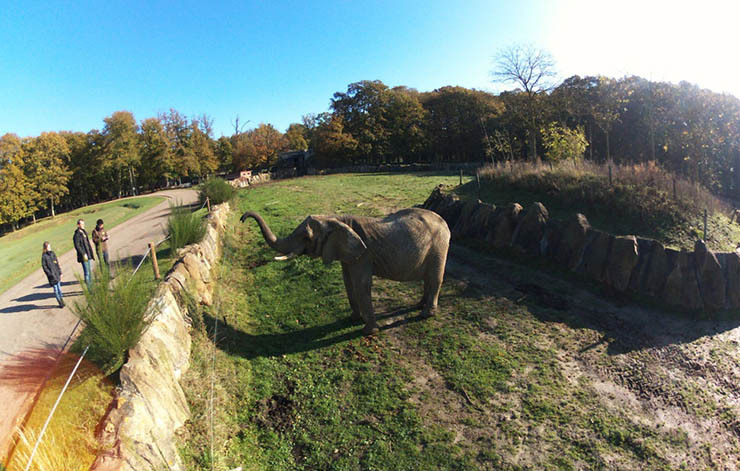
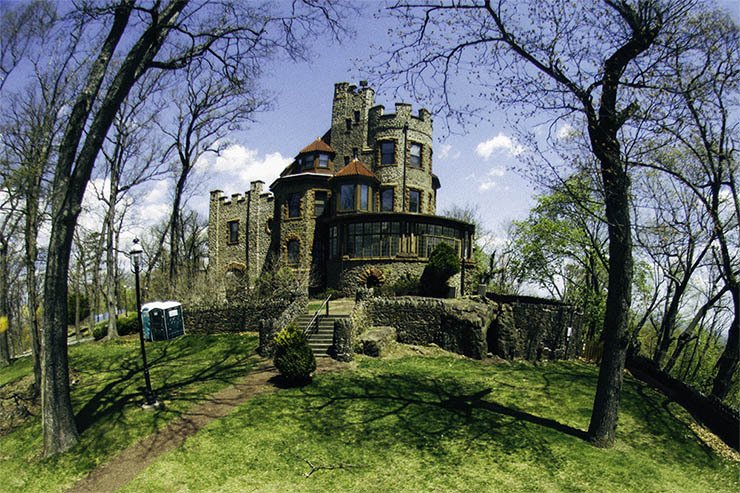

At the same time, there is enough space to make plenty of photos and videos using two batteries. Further content transfer is carried out via the microUSB interface in the drone body, or via Wi-Fi through the application. The photo, by the way, can also be done not only in JPEG, but also in advanced RAW and DNG formats.
To begin the withdrawal, we’ll supplement the above with price information. The cost of Parrot Bebop in the basic version is 39 990 rubles. The advanced modification (with the Skycontroller remote control) is significantly more expensive - already 69 990 rubles, but it is the most convenient in terms of control: any novice “pilot” will easily cope with the drone even in a small room, not to mention an open area.
For this price, we have a nice and relatively compact quadrocopter with excellent handling, a convenient application and good video and photo output. There were no problems with management and you really enjoy the flights. There are also shortcomings, and all the most critical ones are related to resources. Two batteries designed for a quadcopter will provide a maximum of half an hour of using the device with stunts, fast flights and shooting in different modes. The inability to connect memory cards will often make all the footage.
In general, Parrot Bebop is an ideal option for those who buy a quadrocopter for periodic outdoor entertainment with fixing the process on a good camera, provided there is no desire to spend money on more advanced counterparts like DJI Phantom.
2: And on my 12th, and who are you waiting for a boy or a girl more?
1: Boy
2: Why?
1: Helicopter I want a radio-controlled
Bashorg.

Sorry, it's just hard to start a quadcopter review from something else. So. The French company Parrot became known in 2010 and entered the small company of manufacturers involved in the rise in popularity of quadcopters in the consumer market. Since then, Parrot has managed to receive an award at CES 2010 in the Electronic Gaming Hardware nomination, and then release two more modifications of the aircraft. The latest model Parrot Bebop Drone (aka AR.Drone 3 ) came to us for a review and we are ready to share our impressions.
The initial success of Parrot is largely due to the original concept of synthesizing several technical ideas at once, which were developed throughout all three versions of the device. The quadcopter is piloted using a smartphone or tablet on iOS or Android, and synchronization is performed via a Wi-Fi network “originating” from the drone itself. Such "mobility" for the past generation of quadcopters allowed to create amateur applications with which the flight turns into an adventure with additional reality. Finally, Linux OS is used as a software filling, which allows you to fix various bugs by updating the firmware.
')
Appearance and equipment
We received an overview of the advanced package of Parrot Bebop Drone, which includes:
- Quadcopter itself;
- Three batteries;
- Two protective bumper;
- Spare propellers;
- Charger;
- A set of plugs for different types of outlets;
- Puller for propellers;
- Skycontroller remote control;
- Instructions.

Unlike AR.Drone 2, the new Parrot Bebop has become much more compact and now looks more like a drone spy with an aggressive design, rather than a massive helicopter with an overall hull. We got the device in red and, I must say, this option looks the most predatory. Yellow and blue color options are also provided. Such a bright color scheme will allow not to lose the copter from the view in the open area.
The main material of the frame is ABS plastic, reinforced with fiberglass. Propellers made of polycarbonate, spaced apart. "In the bare" state, they are not protected from collision while flying and, accordingly, can easily hurt. With AR.Drone 2, a large protective frame was envisaged, framing the drone around the perimeter. Here, in order to reduce the sail, it is proposed to use two more compact foam bumpers.

The back of the case is designed to install the battery. It is fixed in small slots, and then fixed with the body of the drone with a velcro fastener. This mount does not look very reliable, but accidental loss of the battery pack is excluded. From here you can also see the shock-absorbing rubber pads, located between the body of the copter and the frame. They are designed to deal with vibration, which in turn adversely affects, for example, video filming.

The front is decorated with impressive dimensions of the "eye" of the camera, which has been significantly improved since the second version of the drone. A 14-megapixel camera with a wide-angle lens “Fisheye” allows you to shoot video in FullHD format, as well as a photo in the form of a round panorama at maximum resolution.

Skycontroller control panel is supplied only in an extended set. It allows you to conveniently fix the tablet and control using separate hardware keys and two joysticks.

The console itself is running Android and is equipped with a whole arsenal of iron, which also allows you to increase the distance of remote piloting to 2 kilometers. The latter is achieved through a dual-band antenna. In the basic version, piloting is carried out through the proprietary application Freeflight 3.0, available for devices on Android , iOS and Windows Phone (beta) .
By screws!
To liven up the quadcopter, you need to connect the battery and press a small key on the back of the case. After that, the LED starts flashing green, indicating that the system has started booting up and the network is “booming”. In the case of using a smartphone or tablet for piloting, the maximum range reaches 250 meters due to four antennas with a frequency of 2.4 and 5 GHz and Wi-Fi 802.11ac MIMO. As for the height, the manufacturer recommends a distance of 12 meters. It is quite possible to rise higher, but only in conditions of calm weather - the weight of the copter is only 380 grams without protective bumpers.

However, if the weather conditions do not threaten the drone with wind drift, then you can safely turn off the eye and fly freely. If the device is removed within the range of the network and loses the connection, it will automatically return to the launch point via GPS, having previously typed 10 meters in height.

From a fully charged battery with a capacity of 1200 mAh, the drone can fly for about 10-15 minutes with a maximum speed of 45 km / h. When recording video, the running time is reduced by a couple of minutes.

In previous versions of the company's drones, the figures were similar, taking into account less powerful cameras and engines. As mentioned above, the kit comes with three universal batteries at once - two are designed directly for the copter, and one for the Skycontroller. To replenish the charge of the battery, it takes about 90 minutes of charging.
Control. Freeflight 3.0 and Skycontroller
As in the previous version of the application, Freeflight 3.0 was created not only to control the quadcopter. For example, through it you can calibrate the device and update the firmware. By the way, just a few days ago Parrot updated the application for iOS, which includes the following changes:
List of changes
- New SkyController buttons re-configuration settings
- New SkyController Bebop radar and co-piloting mode
- New Academy flight summary available on big screens
- Internal memory available free space indicator
- Battery details added graph in academy
- Anti flickering feature
- You can configure the maximum distance pilot / drone before getting a warning
- Flights to private by default
- Settings pages have been reordered
All functions are available from the main menu after synchronizing the device with the drone. The settings indicate the initial position of the drone in height, to which it rises after the start of piloting. By the way, the distance is determined by the ultrasound module located on the bottom of the case.

The range finder can force the drone to do unexpected maneuvers while controlling the room. For example, if the room is filled with furniture, the range finder will calculate the distance directly from the near obstacle, and not from the floor. It is not excluded that after finding the next imaginary landmark, the drone will be able to rest against the ceiling. The design of the copter is made in such a way that the collision will occur directly to the body. This means that damage to the propellers in this scenario is excluded.

In piloting mode, the video from the camera on which the navigation marks are marked is transmitted to the screen. So, in the middle a small icon is shown with the quadcopter position for monitoring in case the drone is out of sight. Information about the speed of the copter, height, signal level and battery charge are displayed at the bottom of the screen.

Management is carried out by virtual joysticks. The thumb of the left hand will adjust the height of the flight and other movements, and the inclinations are made through the accelerometer by tilting the device in the appropriate direction. The left joystick is designed to control the angle of the camera. The individual keys on the right side of the display are responsible for flips, shooting video and panoramic photos.

Another interesting feature is the “flight plan.” By analogy with more serious drones, Parrot Bebop is able to perceive geolocation commands through the application. It is enough to map a few marks, after which the copter will automatically overcome the intended trajectory. Flight programming becomes available through the GNSS chip and tracking system via GLONASS and GPS.

In general, the control system using the application remains the same. The behavior of the copter has changed significantly - Parrot Bebop responds more smoothly and predictably to all commands. This is especially felt when monitoring with the help of Skycontroller. The device provides several options for control.


If a maximum range is required, only Skycontroller should be used. On the case are indicators of the charge of the console and the drone, as well as the signal level, which, in fact, allows you to do without a tablet or smartphone.

If you use a controller paired with a tablet, which is inserted into a special holder (thanks to which a tablet with any popular diagonal will fit), then the range will be limited to the near network, and the control will be carried out using the remote controls. In this case, the physical keys for navigating the mobile application also become available, and this, it is necessary to recognize, is the most convenient option for controlling the drone.
Finally, in the case of the console there is an HDMI connector, through which it will be possible to bring the image to the optional FPV glasses. In this case, it is proposed to tilt the camera directly by moving the head. It was not possible to test this type of use, however, taking into account the wide-angle lens, the effect should be quite funny.

Photo and video
Optical stabilization of the frame in the camera is not provided, however, the copter is equipped with three-axis motion sensors. This allows you to keep the angle with any deviations of the drone, and even during tricks, such as the standard "barrel". For all the calculations, a proprietary dual-core (Cortex 9) Parrot P7 processor with a quad-core graphics accelerator is responsible.
Video and snapshots are recorded on an internal flash drive with a capacity of 8 gigabytes. Here you can complain about the developers, since there is really little space, especially with the support for FullHD recording in MPEG4 format. Photos are a little clickable:



At the same time, there is enough space to make plenty of photos and videos using two batteries. Further content transfer is carried out via the microUSB interface in the drone body, or via Wi-Fi through the application. The photo, by the way, can also be done not only in JPEG, but also in advanced RAW and DNG formats.
Total
To begin the withdrawal, we’ll supplement the above with price information. The cost of Parrot Bebop in the basic version is 39 990 rubles. The advanced modification (with the Skycontroller remote control) is significantly more expensive - already 69 990 rubles, but it is the most convenient in terms of control: any novice “pilot” will easily cope with the drone even in a small room, not to mention an open area.
For this price, we have a nice and relatively compact quadrocopter with excellent handling, a convenient application and good video and photo output. There were no problems with management and you really enjoy the flights. There are also shortcomings, and all the most critical ones are related to resources. Two batteries designed for a quadcopter will provide a maximum of half an hour of using the device with stunts, fast flights and shooting in different modes. The inability to connect memory cards will often make all the footage.
In general, Parrot Bebop is an ideal option for those who buy a quadrocopter for periodic outdoor entertainment with fixing the process on a good camera, provided there is no desire to spend money on more advanced counterparts like DJI Phantom.
Source: https://habr.com/ru/post/365771/
All Articles